Can you find these paintings? Can you add the missing descriptions?
Enjoy your visit to Monet’s art garden! Here you can download the CITINERARY pdf.
Monet: The Late Years | de Young museum | February 16–May 27, 2019
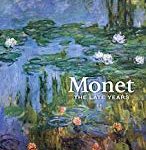
The exhibition features nearly 50 paintings by Claude Monet dating mainly from 1913 to 1926, the final phase of the artist’s long career. During his late years, the well-traveled Monet stayed close to home, inspired by the variety of elements making up his own garden at Giverny, a village located about forty-five miles from Paris. With its evolving scenery of flower beds, footpaths, willows, wisteria, and nymphaea, the garden became a personal laboratory for the artist’s concentrated study of natural phenomena. The exhibition will focus on the series that Monet invented, and just as important, reinvented, in this setting. In the process, it will reconsider the conventional notion that many of the late works painted on a large scale were preparatory for the Grand Decorations, rather than finished paintings in their own right. Boldly balancing representation and abstraction, Monet’s radical late works redefined the master of Impressionism as a forebear of modernism.
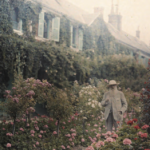 “The man who conceived and established this small, familiar, magnificent world of his own is not only a great artist in the creation of his paintings, but also in the environment he has made for himself, for his own delight. This house and garden are likewise a work of art, and Monet has invested his life in the creating and perfecting it.”
“The man who conceived and established this small, familiar, magnificent world of his own is not only a great artist in the creation of his paintings, but also in the environment he has made for himself, for his own delight. This house and garden are likewise a work of art, and Monet has invested his life in the creating and perfecting it.”
– Gustave GeffroyWhere are the house and garden where Monet lived his last years?
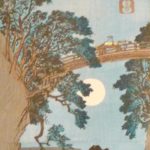 In 1893 Monet added to his property, acquiring another plot of land across the street from his home. After some debate with the local municipality, he received permission to divert the Epte River to create a pond for cultivating water lilies, a flower he may have first learned about from the horticultural display at the 1889 Exposition Universelle, in Paris. The garden’s design may have also been inspired by Monet’s extensive collection of Japanese prints, which the artist began amassing in the 1860s and had hanging in his dining room. His water-lily garden served as a perfect foil to the more traditional flower garden surrounding his home, which was organized in a grid with rectangular flowerbeds and grand allés.
In 1893 Monet added to his property, acquiring another plot of land across the street from his home. After some debate with the local municipality, he received permission to divert the Epte River to create a pond for cultivating water lilies, a flower he may have first learned about from the horticultural display at the 1889 Exposition Universelle, in Paris. The garden’s design may have also been inspired by Monet’s extensive collection of Japanese prints, which the artist began amassing in the 1860s and had hanging in his dining room. His water-lily garden served as a perfect foil to the more traditional flower garden surrounding his home, which was organized in a grid with rectangular flowerbeds and grand allés.
Can you find a Monkey Bridge print by Hiroshige and a picture of Monet in his dining room?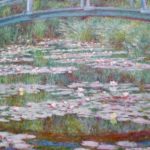 In 1899, Monet painted 12 works from a single vantage point, focusing on the arching blue–green bridge and the microcosm of his water garden. Among the 12 works was the National Gallery’s Japanese Footbridge. Monet designed and built the landscape that appears in the painting—from the bridge to the pond and its shape, to the water lilies and other plantings. The artist, who as a leader of the impressionists had espoused the spontaneity of directly observed works that capture the fleeting effects of light and color, had in these later paintings subjected a nature he re–created to sustained, meditated scrutiny.
In 1899, Monet painted 12 works from a single vantage point, focusing on the arching blue–green bridge and the microcosm of his water garden. Among the 12 works was the National Gallery’s Japanese Footbridge. Monet designed and built the landscape that appears in the painting—from the bridge to the pond and its shape, to the water lilies and other plantings. The artist, who as a leader of the impressionists had espoused the spontaneity of directly observed works that capture the fleeting effects of light and color, had in these later paintings subjected a nature he re–created to sustained, meditated scrutiny.
Can you find The Japanese Footbridge?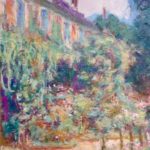 Monet’s artistic vision knew no limits. After purchasing the property across from his home, Monet set about requesting permission from the local authorities to create a small diversion in the Epte River to create a pond, in which he planned to cultivate aquatic plants. He also requested permission to construct two bridges to cross this water garden. The local neighbors and farmers vigorously opposed the plan, fearing the possible pollution of their water source. A series of letters between Monet and his wife Alice document the artist’s sharp temper and steadfast resolve to achieve his vision. In one letter, Monet exclaims, “To hell with the natives of Giverny.” Years later, he again engaged with the local government, paying for all the roads in town to be paved to alleviate the dust that constantly contaminated the leaves of his water lilies.
Monet’s artistic vision knew no limits. After purchasing the property across from his home, Monet set about requesting permission from the local authorities to create a small diversion in the Epte River to create a pond, in which he planned to cultivate aquatic plants. He also requested permission to construct two bridges to cross this water garden. The local neighbors and farmers vigorously opposed the plan, fearing the possible pollution of their water source. A series of letters between Monet and his wife Alice document the artist’s sharp temper and steadfast resolve to achieve his vision. In one letter, Monet exclaims, “To hell with the natives of Giverny.” Years later, he again engaged with the local government, paying for all the roads in town to be paved to alleviate the dust that constantly contaminated the leaves of his water lilies.
Can you find The Artist’s House? Monet traveled as far north as Norway and as far south as Venice to look for different motifs, but he always returned to the places he knew best. He painted this river in Paris, Argenteuil, Vétheuil, and where it emptied into the English Channel. He turned to it again in the summers of 1896 and 1897 for his series of canvases showing how it looked at dawn. He set up his easel at three-thirty each morning in a boat moored just off the riverbank near his house at Giverny. There he sat and painted the series of twenty-one canvases to which this one belongs.
Monet traveled as far north as Norway and as far south as Venice to look for different motifs, but he always returned to the places he knew best. He painted this river in Paris, Argenteuil, Vétheuil, and where it emptied into the English Channel. He turned to it again in the summers of 1896 and 1897 for his series of canvases showing how it looked at dawn. He set up his easel at three-thirty each morning in a boat moored just off the riverbank near his house at Giverny. There he sat and painted the series of twenty-one canvases to which this one belongs.
Can you find the painting depicting the river in the morning? What river is it?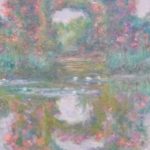 This painting is one of a small series done late in the artist’s life at Giverny. He had done several series showing the same subject matter at different times of day, moving his easel with the changing light and weather conditions. His intent was to illustrate the ways in which light and weather change the appearance of objects.
This painting is one of a small series done late in the artist’s life at Giverny. He had done several series showing the same subject matter at different times of day, moving his easel with the changing light and weather conditions. His intent was to illustrate the ways in which light and weather change the appearance of objects.
Can you find this painting?
When was it painted?
What museum does it come from?
What flower do you think there are in the arches?
What time of the year and of the day?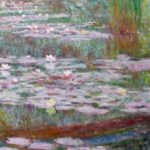 “It took me a while to understand my waterlilies…. I cultivated them without thinking of painting them… A landscape doesn’t captivate you in just one day… And then, all of a sudden, I had a revelation – there was magic in my pond. I seized my palette. Since that moment, I’ve scarcely painted any other subject.”
“It took me a while to understand my waterlilies…. I cultivated them without thinking of painting them… A landscape doesn’t captivate you in just one day… And then, all of a sudden, I had a revelation – there was magic in my pond. I seized my palette. Since that moment, I’ve scarcely painted any other subject.”
Can you find the water lilies in this picture?
How many water lily paintings can you find?
You might need to step into the garden to find them all…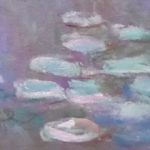 Can you find this painting? What month do you think water lilies bloom in Monet’s garden? What time of the day do you think he painted them?
Can you find this painting? What month do you think water lilies bloom in Monet’s garden? What time of the day do you think he painted them?
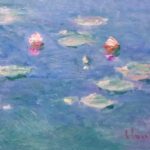 What about these water lilies?
What about these water lilies?
Can you find their painting?
Do you think it was painted at the same time as the previous water lilies? Why or why not?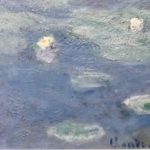 How many water lilies can you see in this painting?
How many water lilies can you see in this painting?
What colors are they?
What else do you notice?
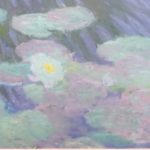 Can you find these water lilies?
Can you find these water lilies?
What else can you see in the painting?
How would you describe it?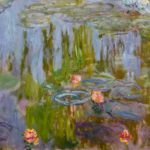
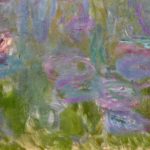
 You can usually find IT in the Impressionist Gallery of the Legion of Honor. As the vista piece that anchors the space running through galleries 14 to 19, IT is an integral and beloved feature of the Museums’ Impressionist collection.
You can usually find IT in the Impressionist Gallery of the Legion of Honor. As the vista piece that anchors the space running through galleries 14 to 19, IT is an integral and beloved feature of the Museums’ Impressionist collection.
Can you find IT in Monet’s garden?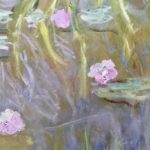 Plants, water, and sky seem to merge in Claude Monet’s evocative painting of his lily pond at Giverny. The disorienting reflections, bold brushstrokes, and lack of horizon line or spatial depth make Water Lilies appear almost abstract. Painted about 1922, it belongs to a grand project that Monet had conceived as far back as 1897: “Imagine a circular room whose wall . . . would be entirely filled by a horizon of water spotted with [water lilies]… the calm and silence of the still water reflecting the flowering display; the tones are vague, deliciously nuanced, as delicate as a dream.”
Plants, water, and sky seem to merge in Claude Monet’s evocative painting of his lily pond at Giverny. The disorienting reflections, bold brushstrokes, and lack of horizon line or spatial depth make Water Lilies appear almost abstract. Painted about 1922, it belongs to a grand project that Monet had conceived as far back as 1897: “Imagine a circular room whose wall . . . would be entirely filled by a horizon of water spotted with [water lilies]… the calm and silence of the still water reflecting the flowering display; the tones are vague, deliciously nuanced, as delicate as a dream.”
Can you find this water lily? Where do you think is the circular room with Monet’s water lilies?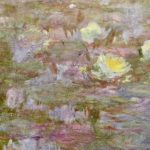 Can you find these water lilies?
Can you find these water lilies?
How would you describe this painting?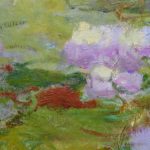
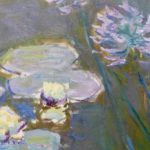

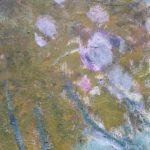 This bird’s eye view, possibly from the Japanese bridge, shows a winding path near the pool, bordered with lush flowers. Monet applied thick purples, blues and greens using bold, even crude strokes. The effects were possibly induced by double cataracts which altered his vision.
This bird’s eye view, possibly from the Japanese bridge, shows a winding path near the pool, bordered with lush flowers. Monet applied thick purples, blues and greens using bold, even crude strokes. The effects were possibly induced by double cataracts which altered his vision.
What flowers are these? Can you find the painting?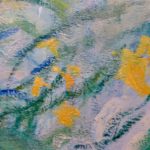
How many water lilies did you find?
What colors were they?
Keep looking for water lilies!
What flowers are these? Can you find them in Monet’s garden?
INSIGHTS | Monet: The Late Years | de Young museum | February 16–May 27, 2019
Monet Discovery Guide . pdf
Shapes and Colors in Monet’s Garden . pdf
